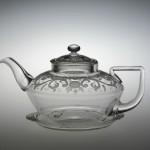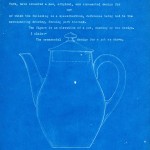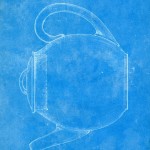
I’m a local girl. My great-grandfather blew the world’s largest light bulb at Corning Glass Works’ “A” factory, just across the river from where I sit at the Museum. The men and women behind the glass fascinate me. So, when I came across early Pyrex brand teapots, I couldn’t wait to share my findings.
The renowned designer Frederick Carder designed the first Pyrex teapots in 1922. He had begun his glassmaking career at Stevens & Williams in England and co-founded Steuben Glass Works with Thomas G. Hawkes in 1903. He would become the art director of Corning Glass Works in 1932.
![“The New Vogue in the Making and Serving of Tea” [advertisement], Corning Glass Works, Ladies’ Home Journal, November 1924, pp. 211.](http://blog.cmog.org/wp-content/uploads/2014/01/Nov.1924EDIT-768x1024.jpg)
“The New Vogue in the Making and Serving of Tea” [advertisement], Corning Glass Works, Ladies’ Home Journal, November 1924, pp. 211.
- Tall Teapot Design Patent, Corning Glass Works, 1922 (CMGL 100113).
- Caption: Round Teapot Design Patent, Corning Glass Works, 1922 (CMGL 100113).
Unlike most Pyrex products, these early teapots were not machine-made. According to a hand-written memo in the Corning Inc. archives, they were blown by a four-man team in Corning Glass Works’ “A” factory. Seth Warren was the gaffer in charge of blowing the teapots, Ernie Frankhauser was the finisher who added the spouts and handles, Dick Begell was the gatherer, and Seth’s son, Stanley, was the bit boy.
The first Pyrex teapots were sold in 1923. Consumers could buy two-cup pots for $2.50, four-cup pots for $3.00, and six-cup pots for $3.50. The “tall” design was discontinued in 1925, and a one-cup “round” design was added for $1.50. In 1929, Corning began offering “engraved” teapots for 50% more than the cost of plain ones. However, we believe these pots were cut rather than engraved. According to the former Steuben glass engraver Max Erlacher, stone wheels cut hard borosilicate glass easier than the copper wheels used by engravers. Simple designs could be added to the wheels to streamline the cutting process.

Pyrex Teapot, Corning Glass Works, designed by Frederick Carder, about 1922-1925, H: 14.6 cm W: 26 cm D: 17.7 cm, gift of June Franklin Wynne in memory of Anna Youngflesh (2003.4.75).
Although third parties were often hired to cut and engrave Pyrex blanks, Corning did much of the work on their own. In 1919, Peter A. Eick came to work in the Pyrex finishing department where he became known for his floral cutting and monograms on a wide range of Pyrex products, especially teapots. He had left his job at the local cutting firm T. G. Hawkes & Company where he was paid $17 a week.
By 1931, Corning began to phase out the original Pyrex teapots in favor of a new design. The new pots had no spout, which advertisements branded a “treacherous snare” for “careless fingers,” and a chromium handle deemed sturdier than “the fragile handle of old-style teapots.” In 1934, Ernie Frankhauser, the finisher who added the “old-style” spouts and handles to the original teapots, was seriously injured on the job. No one could replace his expertise, and the last Carder-designed Pyrex teapot was sold in 1935.
![“Miracles Wrought by a Magic Bubble of Shining Glass” [advertisement], Corning Glass Works, Better Homes & Gardens, June 1931, pp. 68.](http://blog.cmog.org/wp-content/uploads/2014/01/20131218152558532-page-001b-224x1024.jpg)
“Miracles Wrought by a Magic Bubble of Shining Glass” [advertisement], Corning Glass Works, Better Homes & Gardens, June 1931, pp. 68.
The Rakow Research Library is open to the public 9am to 5pm every day. We encourage everyone to explore our collections in person or online. If you have questions or need help with your research, please use our Ask a Glass Question service.




9 comments » Write a comment